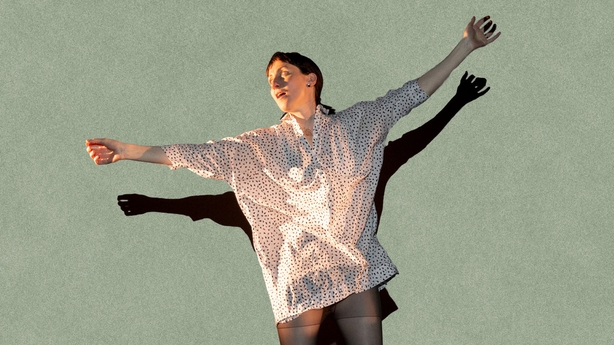Three years ago, writer Róisín Stack set out to explore woman's tireless pursuit of alone time – the result is her new solo show, No Woman is an Island, premiering at Project Arts Centre as part of this year's Dublin Theatre Festival. Róisín introduces the show below.
Text is always my starting point when I make theatre - a short story, a manifesto or an autobiography can form the basis of a new performance. For my upcoming show, No Woman is an Island, I took not just one text as a starting point, but several "artefacts of solitude" to learn how women navigate isolation and aloneness. But my brain was writing cheques my eyes couldn't cash and I soon realised that I’d have to change my whole approach to reading if I was to survive this process and write the performance.
No Woman is an Island is inspired by the lives of great woman thinkers and artists. It plays with the aesthetic of the performance lecture by projecting creative research across the back of the stage. I began by reading diaries (Sylvia Plath, Virginia Woolf, May Sarton) and collecting quotes for projections with great ferocity, freckling every book with sticky tabs. I moved on to autobiographies, essays, papers and prose. My growing reading commitments had to work around parenting and other duties, and I soon found I was picking up books in an ad hoc manner, reading intermittently, in fits and starts as schedules and baby-demands allowed. This approach felt disingenuous but at the same time I was getting results: amassing information, learning about the writers, understanding the subject.
No Woman is an Island is inspired by the lives of great woman thinkers and artists.
A 2005 study states that we’re more inclined toward 'browsing and scanning, keyword spotting, one‐time reading, non‐linear reading, and reading more selectively,’ with less time spent ‘on in‐depth reading, and concentrated reading’than ever before. Maybe I wasn’t out of my depth, as I was starting to fear, but simply a victim of the times (though I wasn’t sure if this was a comfort or more of a concern).
As my writing weeks turned into writing months, piles of books became more numerous, with one book suggesting another suggesting another in a biblical begetting that was eating my small living room. Marguerite Duras fell over Frida Kahlo backed onto Tracey Emin. The library emailed me overdue notices as I tried and failed to be a good citizen and diligent artist. Scanning was the only way I could read but it felt dishonest, given I was trying to delve into the experiences of the writers; I wasn't sure how I could do that if I was rushing over the landscape of their words like a greedy prospector.

In her collection Index Cards, Moyra Davey delves into reading as a form of inspiration for her work: ‘She has the idea that if she can simply plug into the right book then all will be calm, still and right with the world.’ Davey’s honest articulation of her process brought some calm and stillness to mine, validating the often chaotic, and always lonely, creative pursuit.
At a certain point, I had to trust that I’d absorbed the information that the show required. As Virginia Woolf put it: ‘I don’t feel that I can read seriously and exactly… Rather I want to sort out all the ideas that have accumulated in me.’ I found myself bravely returning books to the library and starting to construct my own world in relation to the texts. I set my own experience of the research alongside the stories and struggles of these women to create a piece that (spoiler alert) is as open-ended as the process of making it.
Anne Lamott’s Bird by Bird reminds us that reading is very much part of the writing process and that in order to write well, you must read widely and carefully. Francine Prose goes one further in her book Reading Like a Writer, encouraging a ‘close reading’ of texts, where you take the time to examine the writer’s use of language, structure and rhythm. Though I never had time for close-reading, I unconsciously absorbedthe paragraph-length diary entries and fragmented text of auto-fiction works (Bluets; Department of Speculation; 300 Arguments) which informed the writing structure for No Woman is an Island.
Whether dipped into or devoured, books are a formidable accompaniment to time alone, which might be why certain Buddhist practices hold that reading and writing detract from the experience of pure solitude. Maybe I could have made a piece about solitude by meditating intensely or pursuing a more extreme philosophical experience without book, paper or pen, but then it wouldn’t be this piece. And I would never have come across the glorious and agonising experiences of women who sacrificed so much in their commitment to creativity and themselves. Through reading their texts I wrote my story and forged my own honest, haphazard path: ‘Writing is a religious act: it is an ordering, a reforming, a relearning and reloving of people and the world as they are and as they might be.’ – Sylvia Plath.
No Woman is an Island previews at the Bank of Ireland Theatre, Galway on 4th, 5th & 7th October and opens at Dublin Theatre Festival from 10th – 14th October at Project Arts Centre - find out more here.

